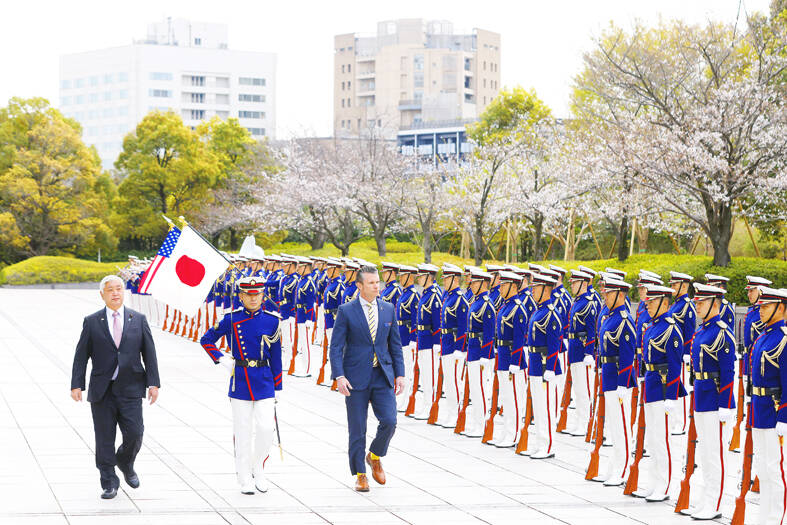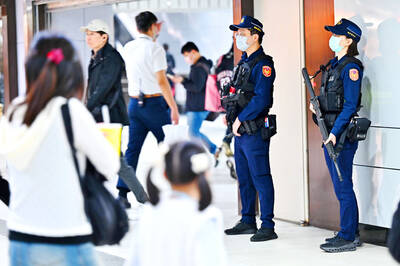The US will ensure “robust, ready and credible deterrence” across the Taiwan Strait, US Secretary of Defense Pete Hegseth said yesterday, calling China “aggressive and coercive.”
“America is committed to sustaining robust, ready and credible deterrence in the Indo-Pacific, including across the Taiwan Strait,” said Hegseth, who is in Asia on his first official visit and traveled to Japan from the Philippines.
Beijing has stepped up military pressure over the past few years around Taiwan, including near-daily air incursions, and has not ruled out using force to bring it under its control.

Photo: EPA-EFE
Hegseth added that Japan was indispensable in tackling Chinese aggression by helping Washington establish a “credible” deterrence in the region, including across the Taiwan Strait.
“We share a warrior ethos that defines our forces,” Hegseth told Japanese Minister of Defense Gen Nakatani at a meeting in Tokyo.
Calling Japan a “cornerstone of peace and security in the Indo-Pacific,” the Pentagon indicated that US President Donald Trump’s government would, like past administrations, continue to work closely with its key Asian ally.
Japan hosts about 50,000 US military personnel, squadrons of fighter squadrons and Washington’s only forward-deployed aircraft carrier strike group along a 3,000km archipelago that helps hem in Chinese military power.
Trump’s “America first” approach could mean weakening the US commitment for security in the region, analysts have warned.
However, Hegseth said the previous US administration had “created this vacuum, a perception that America was not strong and wasn’t prepared to deter conflicts from starting.”
“Our job now at this moment, here with our allies, is to say: We are re-establishing deterrence. Peace through strength, with America in the lead, is back,” he said.
He said Washington would “build an alliance so robust that both the reality and the perception of deterrence is real and ongoing, so that the communist Chinese don’t take the aggressive actions that some have contemplated they will.”
Hegseth hailed the “extraordinary strength of America’s alliance with Japan.”
“President Trump has also made it very clear, and we reiterate, we are going to put America first, but America first does not mean America alone,” he said. “America and Japan stand firmly together in the face of aggressive and coercive actions by the communist Chinese.”
There have also been expectations that, as he has done in Europe, Trump would press the US’ allies in Asia to increase military spending and to do more to ensure their own defence.
The Japanese government has also been reeling from Trump’s decision to impose a 25 percent tariff on auto imports from Thursday.
Hegseth said he “did not talk specific numbers” about defense spending in his talks with his Japanese counterpart.
“We’re confident that Japan will make the correct determination of what capabilities are needed inside our alliance to make sure we are standing shoulder to shoulder,” Hegseth said.
“They have been a model ally, and we have no doubt that will continue, but we also both recognize everybody needs to do more,” he said.
Nakatani said he told Hegseth that spending should be “implemented based on Japan’s own judgement and responsibility.”
“I also explained Japan has continuously been working on a drastic strengthening of our defense capability ... on which we received understanding from the US side,” he said.
Japan has been shedding its strict pacifist stance, moving to obtain “counterstrike” capabilities and doubling military spending to the NATO standard of 2 percent of GDP.
Former US president Joe Biden and former Japanese prime minister Fumio Kishida announced a “new era” in cooperation at a summit at the White House last year.
That included the creation of a new Japan-based US headquarters, which would take over operational oversight of US forces in Japan from the US Indo-Pacific Command in Hawaii.
It would serve as a counterpart to Japan’s new Joint Operations Command for all its armed forces, making the two countries’ militaries more nimble in case of a crisis over Taiwan or the Korean peninsula.
“We will accelerate our efforts to improve inter-operability and conduct effective bilaterally joint activities across the spectrum from peacetime to contingency,” Nakatani said.
“Expansion of the Japan-US presence in [Japan’s] southwestern region is one of our alliance’s top priorities,” he said.
Additional reporting by Reuters

TRAGEDY STRIKES TAIPEI: The suspect died after falling off a building after he threw smoke grenades into Taipei Main Station and went on a killing spree in Zhongshan A 27-year-old suspect allegedly threw smoke grenades in Taipei Main Station and then proceeded to Zhongshan MRT Station in a random killing spree that resulted in the death of the suspect and two other civilians, and seven injured, including one in critical condition, as of press time last night. The suspect, identified as a man surnamed Chang Wen (張文), allegedly began the attack at Taipei Main Station, the Taipei Fire Department said, adding that it received a report at 5:24pm that smoke grenades had been thrown in the station. One man in his 50s was rushed to hospital after a cardiac arrest

A car bomb killed a senior Russian general in southern Moscow yesterday morning, the latest high-profile army figure to be blown up in a blast that came just hours after Russian and Ukrainian delegates held separate talks in Miami on a plan to end the war. Kyiv has not commented on the incident, but Russian investigators said they were probing whether the blast was “linked” to “Ukrainian special forces.” The attack was similar to other assassinations of generals and pro-war figures that have either been claimed, or are widely believed to have been orchestrated, by Ukraine. Russian Lieutenant General Fanil Sarvarov, 56, head

SAFETY FIRST: Double the number of police were deployed at the Taipei Marathon, while other cities released plans to bolster public event safety Authorities across Taiwan have stepped up security measures ahead of Christmas and New Year events, following a knife and smoke bomb attack in Taipei on Friday that left four people dead and 11 injured. In a bid to prevent potential copycat incidents, police deployments have been expanded for large gatherings, transport hubs, and other crowded public spaces, according to official statements from police and city authorities. Taipei Mayor Chiang Wan-an (蔣萬安) said the city has “comprehensively raised security readiness” in crowded areas, increased police deployments with armed officers, and intensified patrols during weekends and nighttime hours. For large-scale events, security checkpoints and explosives

PUBLIC SAFETY: The premier said that security would be tightened in transport hubs, while President Lai commended the public for their bravery The government is to deploy more police, including rapid response units, in crowded public areas to ensure a swift response to any threats, President William Lai (賴清德) said yesterday after a knife attack killed three people and injured 11 in Taipei the previous day. Lai made the remarks following a briefing by the National Police Agency on the progress of the investigation, saying that the attack underscored the importance of cooperation in public security between the central and local governments. The attack unfolded in the early evening on Friday around Taipei Main Station’s M7 exit and later near the Taipei MRT’s Zhongshan